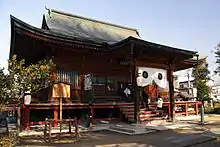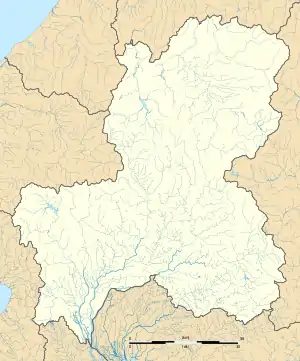Hida Kokubun-ji
Hida Kokubun-ji (飛騨国分寺) is a Shingon-sect Buddhist temple in the city of Takayama, Gifu, Japan. It is one of the few surviving provincial temples established by Emperor Shōmu during the Nara period (710 – 794).[1] Due to this connection, the foundation stones of the Nara period pagoda located on temple grounds were designated as a National Historic Site by the Japanese government in 1929.[2]
| Hida Kokubun-ji 飛騨国分寺 | |
|---|---|
 Hida Kokubun-ji Hondō | |
| Religion | |
| Affiliation | Buddhist |
| Rite | Shingon |
| Location | |
| Location | 1-83 Sōwa-chō, Takayama-shi, Gifu-ken |
| Country | |
 Shown within Gifu Prefecture  Hida Kokubun-ji (Japan) | |
| Geographic coordinates | |
| Architecture | |
| Founder | Emperor Shōmu |
| Completed | c.741 |

History
The temple is located in downtown Takayama, a short distance from Takayama Station. The exact date of construction is believed to be around 757, over 15 years from the foundation of the provincial temple system in 741. The temple claims that it was founded by the famed wandering prelate Gyōki without any historical evidence. However, records indicate that the original temple burned down in 819 and was rebuilt in 855. The existing Hondō dates from the Muromachi period. The 7-story pagoda also dates from the same period, burned down during the Ōei period and was reconstructed again in 1585. It was burned down again in the battles between Kanemori Nagachika and Anegakoji Yoritsuna and a 3-story pagoda was built in its place in 1615. This structure also burned down in 1791 and was rebuilt in 1820.
In 1695, when Takayama Castle was destroyed, the Hida Kokubun-ji inherited some of its structures, including the main gate.
Listed cultural properties
- National ICPs
- Hondō, built in mid-Muromachi period
- Seated statue of Yakushi Nyorai, Heian period
- Standing statue of Kannon Bosatsu, Heian period
- Tachi sword, donated by the Ena clan
- Gifu Prefecture ICPs
- Seated statue of Amida Nyorai, Kamakura period
- Standing statue of Fudō Myō-ō, Kamakura period]]
- 3-story Pagoda, Edo period
- Takayama City ICP
- Bell tower gate
- Plaque on rear gate
- National Natural monument
- Ginkgo biloba tree, estimated age of 1250 years
References
- "Kokubunji". Encyclopedia of Japan. Tokyo: Shogakukan. 2012. Archived from the original on 2007-08-25. Retrieved 2012-05-04.
- "飛騨国分寺塔跡" (in Japanese). Agency for Cultural Affairs.
External links
| Wikimedia Commons has media related to Hida-kokubunji. |
- Official website (in Japanese)
- Gifu prefecture official site